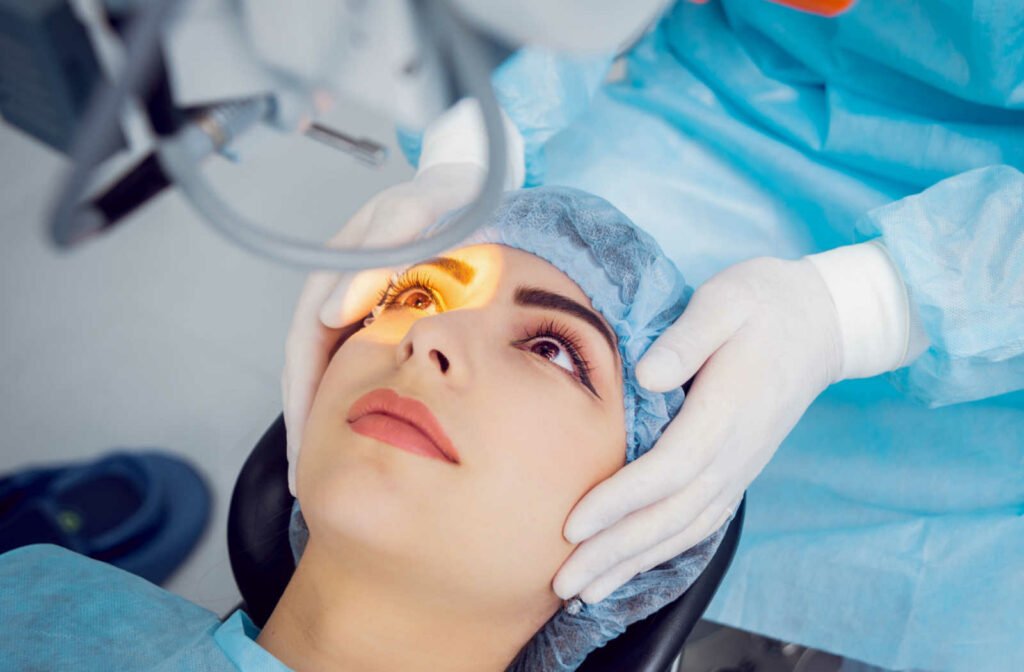Cataract surgery is a highly successful procedure that can result in significant visual improvements. Depending on your overall eye health and vision, as well as the type of lens chosen for implantation, you may need to wear reading glasses for clear, close-up vision after surgery.
Aligning with our patient-first philosophy, your doctor will accurately assess your eyes to advise and educate you on your options. If it’s right for your treatment plan, we may recommend advanced intraocular lenses (IOLs) that provide clear vision at all distances and can eliminate the need for glasses on a day-to-day basis.
Discover the precision of cataract surgery to meet your unique vision needs.
What Is a Cataract?
A cataract occurs when your eye’s natural, clear lens becomes cloudy. With age, the lens in your eye can lose its flexibility and become less transparent. Proteins and fibers begin to break down and clump together, causing the cloudiness.
Your eye’s lens is responsible for bending and focusing light to produce a clear image. When the lens becomes cloudy, it can become increasingly difficult to read, drive, or see objects with definition. Other symptoms of cataracts can include:
- Difficulty seeing at night
- Colors appearing faded or yellow
- Seeing “halos” around lights
- Blurred vision
- Frequent prescription changes
If cataracts impact your day-to-day life or make it difficult for your optometrist to examine the back of your eye, they may recommend cataract surgery. Cataract surgery replaces your natural lens with an artificial lens implant, also known as an intraocular lens (IOL).

The Cataract Surgery Process
Prior to Surgery
Your doctor will perform an ultrasound to measure the size and shape of your eye to determine what type of artificial lens implant you’ll need. There are a variety of IOLs available to help meet your vision needs.
Your doctor will discuss the benefits of each lens and recommend the right IOL for you and your eyes. Our goal is to provide you with clear, comfortable vision.
During the Procedure
Your surgeon will either perform your cataract surgery manually or laser-assisted, depending on what is right for you.
For traditional cataract surgery, your surgeon will manually make a small incision in your cornea in order to insert an instrument to break up the clouded lens. This instrument uses ultrasound waves to break up the lens, which is then suctioned out, making room for the artificial lens to be implanted.
Laser-assisted cataract surgery uses innovative technology for advanced precision and improved consistency. This technology maps the unique surface of your eye and programs the exact size, depth, and location for the laser to make the incision. Ultrasound is then used to break up the clouded cataract to be removed, and the new IOL will be implanted.
Laser-assisted cataract surgery can also correct astigmatism if needed. The laser is used to reshape the cornea, helping to give the patient clear vision at all distances.
After Treatment
You can begin to notice improvements in your vision within a couple of days after surgery. It’s normal if your vision appears blurry at first as your eyes adjust and heal. Color will also appear brighter after a cataract is removed.
Follow-up appointments will be scheduled with your eye doctor to monitor healing and the improvement of your vision.
Will You Need Reading Glasses After Cataract Surgery?
There are many factors that your doctor will assess when determining a treatment plan and type of IOL right for you. These factors include overall eye health, presence of astigmatism, current prescription, and visual needs.
Once your eyes are evaluated, you’ll discuss your options with your doctor. There are different types of IOLs that can help treat refractive errors along with removing and replacing the clouded natural lens. Common types of IOLs include:
- Fixed-Focus Monofocal—this lens has a single-strength prescription to help improve your distance vision. You will likely require reading glasses.
- Accommodating-Focus Monofocal—this lens can respond to muscle movement and shift focus between near and distant objects.
- Multifocal—this type of lens works similarly to a bifocal or progressive eyeglass lens. The lens has different areas of focus for near, middle, and distance vision.
- Toric—can help correct astigmatism, a refractive error that causes blurred near and distance vision.
Combining cataract surgery with advanced IOLs can have you seeing clearly at all distances and diminish the need for reading glasses.
Enjoy a Life Free from Frames
The likelihood that you’ll need reading glasses after cataract surgery will depend on your specific treatment plan. Laser cataract surgery is a precise and customizable treatment that can not only replace your clouded lens, it can correct refractive errors such as presbyopia and astigmatism as well.
Discover how cataract surgery can help you achieve brighter, clear vision today. Find a Lake Eye Associates location near you.

